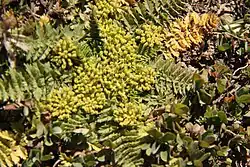Haplosciadium
| Haplosciadium | |
|---|---|

| |
| Scientific classification | |
| Kingdom: | Plantae |
| Clade: | Tracheophytes |
| Clade: | Angiosperms |
| Clade: | Eudicots |
| Clade: | Asterids |
| Order: | Apiales |
| Family: | Apiaceae |
| Genus: | Hochst. |
| Species: | H. abyssinicum
|
| Binomial name | |
| Haplosciadium abyssinicum | |
Haplosciadium is a monotypic genus of flowering plants in the family Apiaceae (Umbelliferae). Its only species is Haplosciadium abyssinicum. It is a flat rosette plant endemic to the Afro-alpine zones on East African mountains, occurring on moist valley bottoms above 3,500 metres (11,500 ft).[1][2] It engages in geocarpy as an adaptation to living on frost-heaved soils.
References
- ^ Truman P. Young & Mary M. Peacock (1992). "Giant senecios and the alpine vegetation of Mount Kenya" (PDF). Journal of Ecology. 80 (1): 141–148. Bibcode:1992JEcol..80..141Y. doi:10.2307/2261071. JSTOR 2261071. Archived from the original (PDF) on 2010-06-10. Retrieved 2012-01-09.
- ^ Ralph Tomlinson (1985). "Observations on the giant groundsels of upper Kilimanjaro". Biological Conservation. 31 (4): 303–316. Bibcode:1985BCons..31..303T. doi:10.1016/0006-3207(85)90088-6.